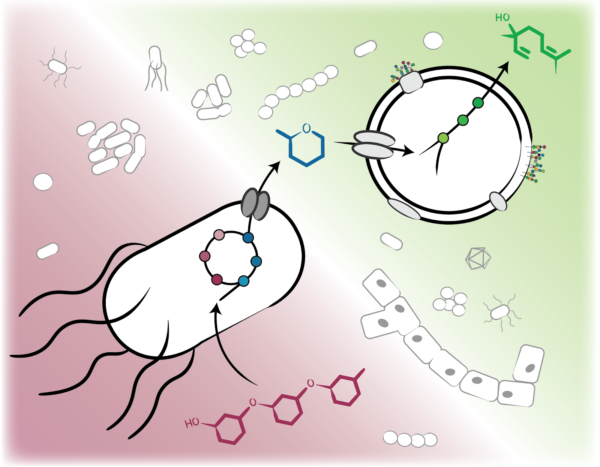Distributed Metabolism
Distributed Metabolism focuses on designing microbiomes that leverage the unique metabolic capabilities of individual microbial species or taxa to collectively produce and/or degrade specific compounds.
Distributed Metabolism focuses on designing microbiomes that leverage the unique metabolic capabilities of individual microbial species or taxa to collectively produce and/or degrade specific compounds.
One of the distinguishing characteristics of a microbiome is that a community of microbes can work cooperatively to produce or degrade compounds, performing chemistry that could not be done by a single species on its own.1Zhang, H., Pereira, B., Li, Z., & Stephanopoulos, G. (2015). Engineering Escherichia coli coculture systems for the production of biochemical products. Proceedings of the National Academy of Sciences, 112(27), 8266–8271. View Publication Metabolic intermediates may be toxic to one species, but readily metabolized by another species. Unique enzyme functionalities may be easier to engineer in one species than another.2Zhou, K., Qiao, K., Edgar, S., & Stephanopoulos, G. (2015). Distributing a metabolic pathway among a microbial consortium enhances production of natural products. Nature Biotechnology, 33(4), 377–383. View Publication Engineering microbiomes, rather than individual microbes, makes it possible to optimize metabolic processes and expand synthesis and degradation outside the chemical compound space found in nature. This theme focuses on how to build and manipulate cooperative microbial communities that perform novel biochemistry, both for synthesis and degradation.

Distributed metabolic processes in an engineered microbiome can facilitate difficult or novel chemical transformations. Production of high-value compounds like biofuels, solvents, flavorings, and polymers can be facilitated by engineered microbiomes. For example as illustrated, lignocellulose degradation can be accomplished by one organism within the microbiome and directly converted into higher-value products, in this case linalool, immediately within the community, leading to more efficient and flexible metabolic processes. Further advances will also enable directed metabolic syntheses across disparate environments (e.g., aerobic and anaerobic) that are otherwise impossible using microbial monocultures.
Distributed Metabolism breaks this challenge down into three goals. Goals 1 and 2 examine how to utilize fixed or reduced carbon and convert it into a new product. Goal 1 focuses specifically on synthesizing more complex molecules from simple inputs (e.g., sugars, organic acids), while Goal 2 focuses on degrading more complex or recalcitrant molecules (e.g., lignocellulose, pollutants) to simpler precursors for new syntheses.3Minty, J. J., Singer, M. E., Scholz, S. A., Bae, C.-H., Ahn, J.-H., Foster, C. E., Liao, J. C., & Lin, X. N. (2013). Design and characterization of synthetic fungal-bacterial consortia for direct production of isobutanol from cellulosic biomass. Proceedings of the National Academy of Sciences, 110(36), 14592–14597. View Publication Goal 3 asks how microbiomes capable of harnessing alternative energy forms for growth (e.g., photoautotrophs, lithoautotrophs) can use that energy to fix inorganic carbon and produce a desired compound.